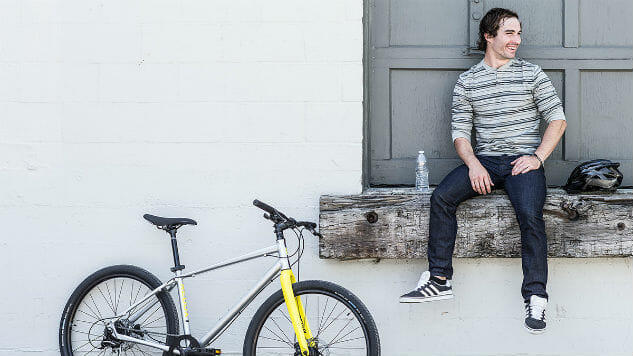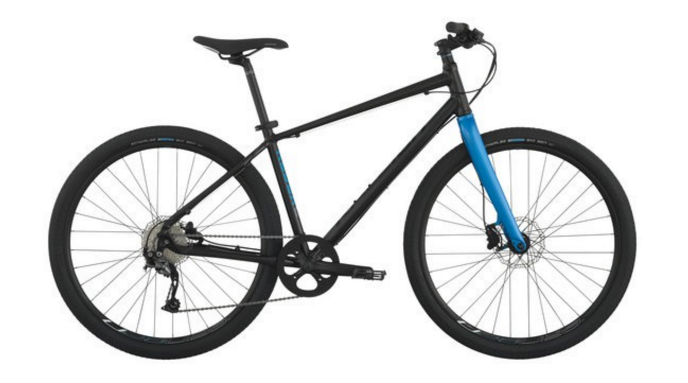A Car Lover Rides a Bike to Work for Two Weeks for Science (And To Geek Out Over Bike Gear)
Tech Features
Riding a bike—at least for me—is a holdover from my youth. Every day, all summer long, I rode my rusty-trusty ten-speed Schwinn to the library, across town to the movie theater, and to a bridge where we fished for carp and did other things that are not worth mentioning. (Pabst Blue Ribbon does not mix well with a 16 year olds already shaky perception of reality.)
Recently, I decided to take up biking again—not for my own enjoyment as much as a pure practical exercise in urban commuter zeitgeist. I wanted to capture the biker ethos and make it my own. I wanted to experience a touch of the blissful “green” mindset so many people in San Francisco and Seattle enjoy—that sense that you’re saving the environment one pedal stroke at a time—or at least you are not inhaling fumes from your own Honda Civic on a daily basis. I wanted to shift my brain and the gears on the bike.
Sadly, my bike muscles and biking mindset have experienced some entropy since I was a teenager. The only “shifter” I use is the one I use to raise and lower my performance chair. As someone who also tests cars on a routine basis, my workday exercise consists of walking the 50 feet from my office to the driveway. (Don’t judge me—I also walk at least 3-4 miles per day at a local wildlife refuge.) I recently lost 20 pounds in two months by walking at least 12,000 steps per day and eating a balanced diet. Biking would provide many existential benefits for my health and outlook on life.
Now for the bad news. It turns out you can’t just jump on a bike and start riding every day about 5 miles one way and back to a local coffee shop with no preparation. I found that out last fall, right before the cold weather hit in full force. Because I’m a persistent bugger, I decided to plan for this spring biking plan by riding a Peloton stationary bike all winter. I tapped into live classes, but mostly stuck to the scenic rides where you feel like you are riding on a mountain pass in Banff. I wanted to at least be physically ready to ride for several miles to work.
Then, about two weeks ago, the cold weather in Minnesota finally abated. I was ready. I decided to test three different bikes with dramatically different purposes in life. I loaded up on biking gear that would help me monitor my progress (including two different bike computers). Most importantly, I was determined to tone up my muscles (both physical and mental) and get back to that viewpoint I had in my teen years that a bike could become a primary transport mechanism.

I started with a Raleigh Redux 2, which is an all-purpose bike that can handle rough roads and long excursions in downtown areas. I love this bike like a brother. We became close, personal friends. Raleigh is going to have to pry the handlebars from my fingers like Ralphie holding onto the slide after seeing Santa Claus in the Christmas Story movie. I might weep a little. It’s sturdy, comfortable, has wide gravel-friendly tires, and costs $750—the sweet spot for a “good” bike. If the phrase “Promax Solve Hydro Disc” sounds a bit techie, just remember this: The brakes on Redux 2 feel like you are driving a Maserati. They gently bring you to a stop with a calm resolve, never jerking you or suggesting that you might go airborne over a curb.
I road about five miles to a coffee shop up the road. At first, I rode without any extra gear. If you’re like me and you don’t already ride every day to work, there are some amazing benefits. I’m typing this right now with a spirited burst thanks to the Redux 2. Seriously. The morning ride took me about 20 minutes, fresh air pouring into my lungs and sunshine unencumbered by a windshield.
Next, I tested a Fat Tire X-Treme E-Grizzly bike, going a different direction north from my house about seven miles one way. This electric bike with fat tires (as you can tell from the name) goes about 30 miles on one charge, weighs 51 pounds, looks like you’re ready for a triathlon, and made me feel like I could ride across my entire state and back without any problems. It costs $1,799, which is still lower than some “high-end” bikes made by companies like Trek or Shinola, plus it’s the only electric I’ve discovered that has fat tires. In my experience, the fat tires gave me a few options. I rode one day on an ATV trail, aiming for the ruts and almost trying to get myself stuck in the mud, but never had any problems. (I later found out people ride this bike professionally and ride in much more extreme conditions than highway ditches.)
My third bike was an interesting departure from the more rugged rides of the Raleigh or Fat Tire models. The Critical Cycles Harper for $199 ships out in a carton. To assemble it, you only need to know the basics and tighten a few bolts. (With the Raleigh, a bike shop had to assemble it. With the Fat Tire, I paid someone for an afternoon to put it together.) In about 10 minutes, I had a super light bike with one gear ready to pound the pavement into submission. My main takeaway with this bike is that it’s extremely portable due to the short wheelbase and weight. The thin tires are ideal for the paved roads and bike trails around my house, but not so much for gravel.

For that goal of capturing the biker ethos, I had to rely on more than just the bikes. My main travel companion was the Wahoo Fitness Elemnt GPS Bike Computer that costs $330. Thank the biking gods I used this gadget. It showed my speed, distance, a clock, and my time on the bike. I can’t overstate the importance of using this as a way to measure your progress. It also has one of the best handlebar brackets known to man, staying perfectly stationary on every ride. You press a button to start your route, and the computer shares a “live ride” on Facebook. Amazing.
Because I never go anywhere without my iPhone 6s, I also used a Griffin Survivor Summit case and Bar Mount. Because I’m so used to Google Maps, I skipped most of the GPS routing features on the Wahoo Fitness Elemnt and used my phone for GPS instead. (I also had bands like Wintersleep and Caveman on repeat for most rides.) The case can withstand a 10-foot drop to concrete and is fully waterproof, which was important one week when the rains came. The mount, once I figured out how to use it, stayed nicely secure on the handlebars of all three bikes.
What else? Because I wanted to immerse myself in what it’s like to ride every day, not just an occasional outing on a perfectly paved bike path, I also tested the Blackburn Central 700 Front light for $100 for night riding. It emitted a bright light with three light levels. Like the Wahoo Fitness bike mount, the one for the light stayed remarkably tight on the handlebar.
I’m a bit of an audiophile, so I also tested out the Hercules WAE Outdoor 04Plus speaker for $90 that includes a bike mount for the handlebars. It’s shock and water-resistant, sounds pristine, and kept me from getting bored on lonely bike paths. It’s a little weird when you pass people on the road and they wonder about your goth-rock musical preferences, so I used the speaker mostly for bike paths where this kind of thing is much more acceptable (and common).
My helmet of choice was the POC Tectal for $190, which has a visor and offers full protection around the back of your head. Once again, that bike-to-work concept matched up well with this helmet, which I wore on every ride, because my route involved some time on the shoulder of highways. It’s just not worth the risk otherwise, even if you look like Timmy riding to school. Ask anyone who rides a bike to work and they will give you an earful about helmet use.

And, I wanted to venture farther away from my house than just the next town over. I tested the Yakima Jetstream roof rack system for $199 and the matching BaseLine Tower mounts for $199. For two bikes, I used the Yakima Whispbar WB200 Fork Mount for $289 which uses a simple locking mechanism for the front and rear tires. You don’t have to remove the tire first, which is handy for the Critical Cycle model which doesn’t have a quick release. This converted my 2008 Toyota Corolla to a road-ready bike hauler, which I used for longer trips. For more flexibility in which car I used, I also tested a Thule Raceway rear bike mount, which costs $450. This mount meant I could use a car I was testing for the week without the roof rack system. Both kits serve different purposes—permanent mount or temporary truck mount.
What didn’t work out? Three main problems. One is that you have to give yourself boundaries. On one trip, I forgot I had a meeting with a garden expert at my house and realized I had no way to get back to my house in less than 20 minutes. He ended up bailing on me. Also, little things seem to crop up. I’m used to taking a “to go” cup of coffee with me after working at a coffee shop. When you are biking, that’s not really possible unless you weigh yourself down further with a thermos. And while cars have USB ports these days, bikes do not (at least, not yet). I had to constantly make sure all of the gadgets were fully charged up, including the electric bike.
There are a few things I still want to test out. I ended up using whatever jacket I had laying around, but when you bike every day, you have to be prepared for the worse. I need to find some good biking gloves that are light but offer some protection against the wind and rain, I need to find a better biking jacket that is light enough for daily rides. I need to invest in some better biking shoes that do not have laces. I have a ways to go! Fortunately, the road is still beckoning. I may be done with this test, but I plan to keep riding—even if I use my own clunky Schwinn.